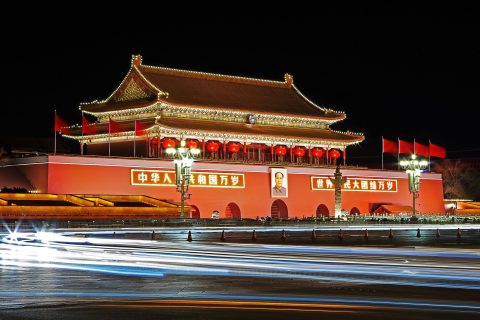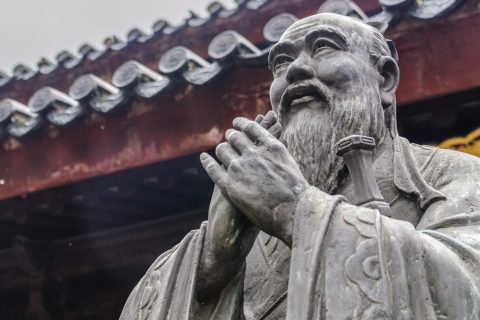
As a country in East Asia, China is located on the west coast of the Pacific Ocean. Its land space is 9.6 million square kilometers and maritime area is 4.7 million square kilometers. The length of China’s eastern and southern continental coastlines surpasses 18,000 kilometers. There are more than 7,600 islands on the sea, of which Taiwan Island is the largest, with an area of 35,798 square kilometers. China shares a border with 14 countries in land and eight countries by sea. There are 4 municipalities, 23 provinces, 5 autonomous regions, 2 special administrative regions. Its capital is Beijing.
National Flag, National Anthem, National Emblem and National Day
The five-star red flag is the national flag of the People’s Republic of China. Red symbolizes revolution. The five five-pointed stars on the flag and their interrelation symbolize the unity of the people under the leadership of the Communist Party of China. The color of yellow on the five-pointed stars is to show brightness on the red ground, which is brighter than white. Each of the four small five-pointed stars points at the center of the big star, which is to show unity around a center. In the form, it also appears compact and beautiful.
The contents of the national emblem of the People’s Republic of China are the national flag, Tiananmen Rostrum, gear and rice spike, which symbolize the new democratic revolutionary struggle since the May 4th Movement and the birth of a new China of the people’s democratic dictatorship based on the alliance of workers and farmers led by the working class.
October 1 marks the birthday, or the National Day, of the People’s Republic of China. The national anthem of the People’s Republic of China is the March of the Volunteers.
Spoken and Written Language
There are 56 ethnic groups in China, making it a multi-ethnic, multi-lingual, multi-dialect and multi-text country. The national lingua franca is Putonghua and the standard Chinese characters. Putonghua is the standard spoken language of Chinese people, with Beijing speech sound as the standard tone, the northern dialect as the basis, and the exemplary modern vernacular writings as the grammatical norms.
Modern Chinese is divided into standard languages (Mandarin) and dialects. Chinese dialects are usually divided into 10 dialects: official dialect, Jin dialect, Wu dialect, Hui dialect, Min dialect, Cantonese dialect, Hakka dialect, Gan dialect, Xiang dialect and Ping dialect.
Capital
The capital city of China is Beijing. It is one of the four municipalities administered directly under the Central Government. The city is the center of national politics, economy, science and culture, and one of the centers of domestic and international exchanges. It is one of the historic and cultural cities and ancient capitals in China.
Population and Ethnic Groups
In history, China has always been one of the world’s most populous countries, accounting for about 20% of the world’s population for a long time. The changes of China’s population have a significant influence on the world population. China currently has a population of about 1.37 billion.
The Chinese nation has a long history. Since ancient times, the ancestors of Chinese people have worked, lived and bred in this land, contributing their talents to the development of Chinese civilization and the establishment of a unified multi-ethnic country. There are 56 ethnic groups in China. Among them, the Han people account for about 92% of the total population.
Climate
China boasts of a vast territory and wide latitude. The distance from the sea is different, coupled with various terrains, forming a variety of climates in China. Speaking of temperature zones, there are tropical, subtropical, warm temperate, medium temperate and cold temperate zone and Qinghai-Tibet Plateau region.
In winter, the temperature difference is huge from the warm south to the cold north. The temperature of Mohe in Heilongjiang is below -30 C, while the temperature southern of the isotherm line is above 0 C. The temperature in Sanya, Hainan Province is above 20 C. In hot summer, the north-south temperature difference is not so obvious. Except for the high-altitude Qinghai-Tibet Plateau and Tianshan Mountains, most of the regions in China are 20 C or above. Many parts of the south are above 28 C. The average temperature in Turpan, Xinjiang is as high as 32 C in July, making it the hot center in China.
Public Holidays
Holidays for all citizens include: New Year’ Day, 1 day off (January 1); Spring Festival, 3 days off (first, second and third day of the first lunar month); Qingming Festival, 1 day off (the day of Qingming); Labor Day, 1 day off (May 1); Dragon Boat Festival, 1 day off (the day of the Dragon Boat); Mid-Autumn Festival, 1 day off (the Day of the Mid-Autumn Festival); National Day, 3 days off (October 1, 2, 3). Holidays and anniversaries for some citizens are: Women’s Day (March 8), women’s half-day holiday; Youth Day (4 May), half-day holiday for young people above 14; Children’s Day (June 1), one day for children and adolescents under the age of 14; Chinese People’s Liberation Army Day (August 1), military personnel take half a day off.
The local people’s governments of the regions inhabited by ethnic minorities shall, in accordance with the customs of each ethnic group, set holiday dates. The day of Great Strike of February 7, the May 30 Movement Day, the July 7 Incident Day, the September 3 Victory Day of Chinese People’s War against Japanese Invasion, the September 18 Incident Day, the Teacher’s Day, the Nurses’ Day, the Journalist’s Day, the Tree Planting Day and other festivals and anniversaries are not on holiday. For public holidays, if they fall on Saturdays and Sundays, they should make up for the holidays on weekdays. Some citizens’ holidays do not make up for them if they coincide with Saturdays and Sundays.



